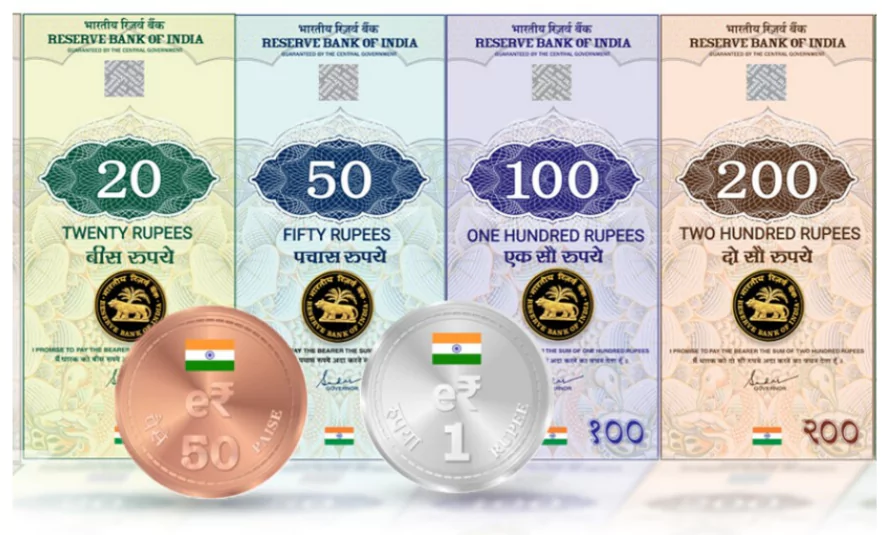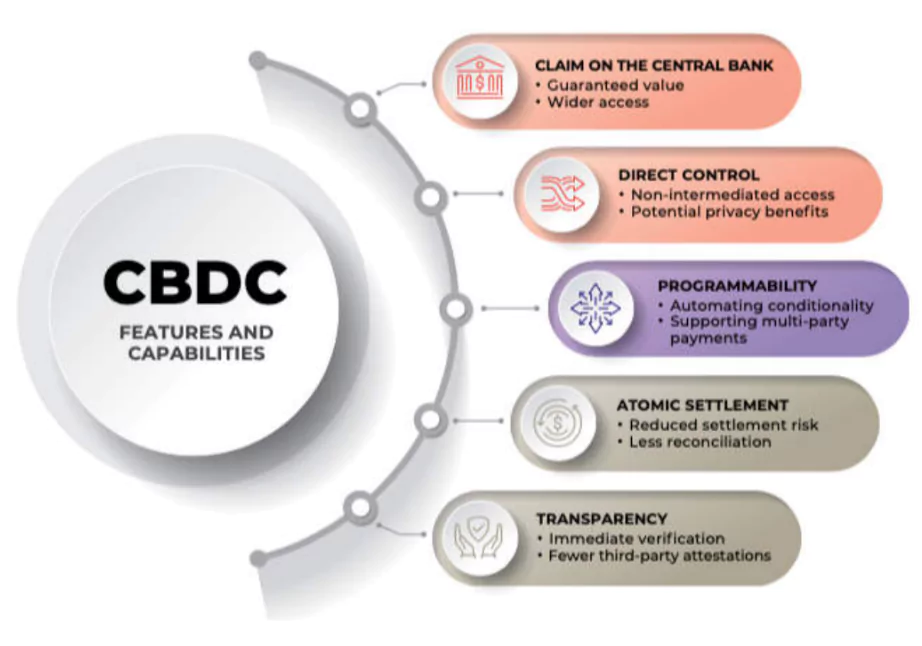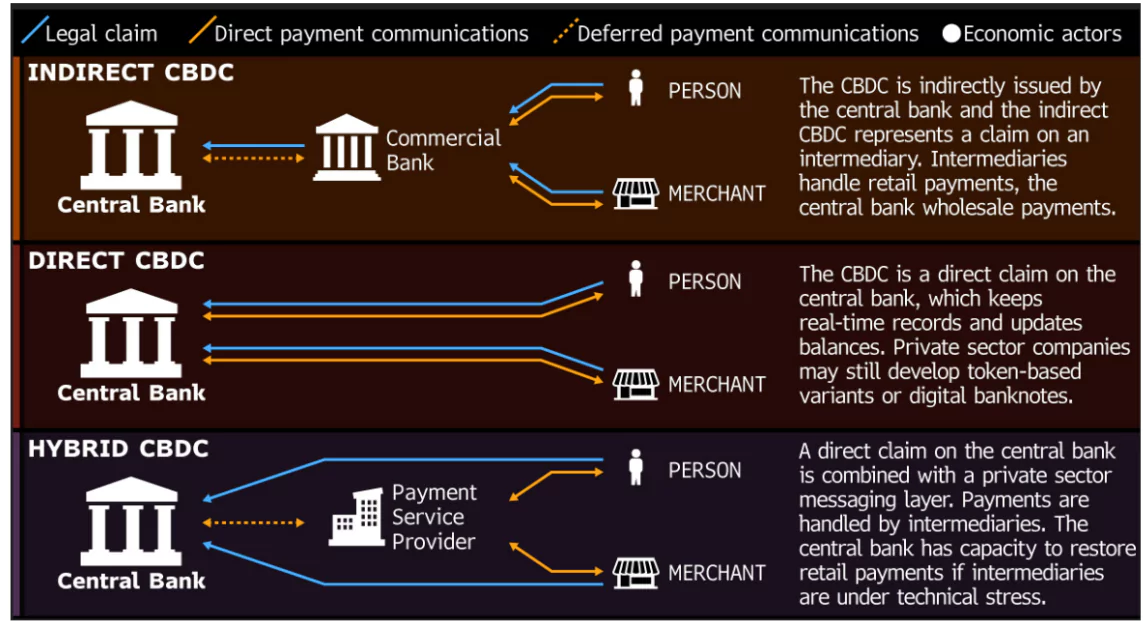A total of 134 countries and currency unions, representing 98% of the global GDP, are currently investigating the potential of Central Bank Digital Currencies (CBDCs).
India’s Initiative

- The Reserve Bank of India (RBI) has been proactive, launching a pilot project for the ‘digital rupee’ in late 2022.
- Types of Digital Rupee
- CBDC-W (Wholesale): For settling secondary market transactions.
- CBDC-R (Retail): A digital version of fiat money, serving as a direct liability of RBI, unlike UPI, which involves commercial banks.
About Central Bank Digital Currencies (CBDCs)

- A Central Bank Digital Currency (CBDC) is a digital form of fiat money issued by a central bank.
- It is also known as the digital fiat currency or digital base money.
- It is distinct from cryptocurrencies and virtual currencies as it is centrally controlled.
- It can be considered a liability of the central bank, similar to physical banknotes and coins.
Enroll now for UPSC Online Course
-
Characteristics of Central Bank Digital Currency (CBDC)
- Digital Counterpart to Fiat Money:
- CBDCs function as digital equivalents to traditional fiat currencies, fulfilling the roles of payment, unit of account, and store of value, similar to paper banknotes.
 Unique Identifiability:
Unique Identifiability:
- Each unit of CBDC is uniquely identifiable, ensuring security and preventing counterfeiting.
- Part of the Base Money Supply:
- CBDCs are considered part of the base money supply, similar to physical currency, and represent a liability of the central bank.
- Digital Bearer Instrument:
- CBDCs can be stored, transferred, and transmitted across various digital payment systems and services, independent of the specific system used for transactions.
-
Implications for Commercial Banks
- Lower Commissions: Potentially lower commission fees due to the streamlined nature of digital transactions.
- Reduced Customer Data-Selling: Less opportunity for commercial banks to sell customer data.
- Deposit and Credit Policies: Changes in deposit accumulation and credit policies due to higher funding costs.

Check Out UPSC CSE Books From PW Store
Cryptocurrency vs. Central Bank Digital Currency (CBDC)
| Feature |
Cryptocurrency |
Central Bank Digital Currency (CBDC) |
| Issuance and Regulation |
Decentralized, no central authority |
Issued and regulated by a central bank |
| Value Stability |
Highly volatile |
Stable, equivalent to fiat currency |
| Legal Status |
Not considered legal tender in most countries |
Considered legal tender, backed by government |
| Anonymity and Privacy |
High degree of anonymity (though public ledger) |
Transactions monitored by central bank |
| Purpose and Use |
Investment, trading, alternative payment |
Financial inclusion, reduced transaction costs, efficient payments |
| Technology |
Decentralized blockchain |
Can use centralized or decentralized technology, but controlled by central bank |
Benefits of CBDC
- Financial Inclusion: CBDC aims to expand access to digital financial services, particularly for those without bank accounts.
- Enhanced Payments: Improves the efficiency and speed of digital payments, including cross-border transactions.
- System Resilience: CBDC can operate independently of commercial banks, making the payment system more robust.
- Economic Growth: Increased financial inclusion can contribute to economic growth.
- Global Integration: CBDC can facilitate cheaper and faster international payments, benefiting India as a major remittance recipient.
- International Collaboration: Participation in global CBDC projects can foster interoperability and cooperation.
Challenges in Implementing CBDC
- Security and privacy: Safeguarding user data and preventing unauthorized access to CBDC wallets are paramount concerns. Striking a balance between privacy and security is essential to build trust among users.
- Scalability: CBDCs need to handle a large volume of transactions efficiently, especially during peak times. Ensuring the system can scale to meet increasing demand is vital for its success.
- Lack of perceived value proposition: For users to switch from existing payment methods, CBDCs need to offer clear benefits such as lower fees, faster transactions, or additional features.
- Monetary policy implications: CBDCs could affect the effectiveness of monetary policy tools. Central banks need to carefully consider how to manage these implications.
- Mitigating Cybersecurity Risks: Protecting against hackers trying to steal funds or personal data.
- Building Public Trust and Education: Gaining public trust and informing people about the benefits and security of CBDCs to overcome resistance to digital currency.
Enroll now for UPSC Online Classes
Way Forward
- Address Privacy and Security: The RBI must tackle privacy and security concerns to encourage widespread adoption.
- Establish Regulatory Standards: Uniform standards for security, privacy, anonymity, and grievance redressal are necessary.
- Promote Interoperability: Enhancing interoperability and offering additional functionalities could incentivize users to adopt the digital rupee.
- International Cooperation: To fully leverage CBDCs for cross-border payments and remittances, India must engage in global CBDC projects once a comprehensive regulatory framework is in place.
![]() 5 Aug 2024
5 Aug 2024


 Unique Identifiability:
Unique Identifiability:

